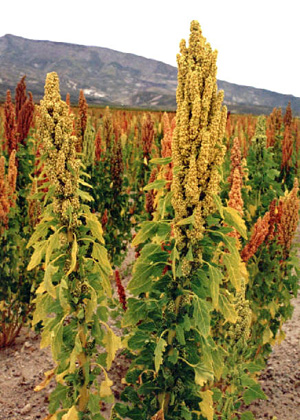
Easy to grow grains
 One of the biggest chinks in our food
independence is grain. We grow sweet corn and could grow field
corn though our consumption of corn meal is so low that the latter
doesn't seem like a good use of space. But we also buy masses of
wheat flour and rolled oats every year, along with some rice. Can
we become less dependent on commercial supplies of grain?
One of the biggest chinks in our food
independence is grain. We grow sweet corn and could grow field
corn though our consumption of corn meal is so low that the latter
doesn't seem like a good use of space. But we also buy masses of
wheat flour and rolled oats every year, along with some rice. Can
we become less dependent on commercial supplies of grain?
I've held off on planting grains because, frankly, I'm terrified of the
extensive process of cutting, threshing, winnowing, and what all.
Instead, I'm currently looking at two grains that used to be staple
crops for Native Americans --- quinoa and amaranth. It sounds
like both can be easily harvested by hand and their seeds aren't
covered with a hull, so they don't need extensive processing.
(Quinoa seeds are covered by a soapy substance called saponin that can
be removed by washing them in cold water in a blender, changing the
water five times or until it is no longer sudsy.)
Maybe I should splurge and buy some of the grain to eat first to see if
we like them, but I've heard they're both delicious cooked like rice,
and that amaranth can also be ground into a flour. Both are
higher in protein and lower in carbohydrates than more traditional
grains, which can't hurt.
Has anyone had luck growing quinoa or amaranth? I think we may
splurge and buy some seeds this year and give them a shot! (Can
you tell I'm in the midst of garden-planning for next year?)
Want more in-depth information? Browse through our books.
Or explore more posts by date or by subject.
About us: Anna Hess and Mark Hamilton spent over a decade living self-sufficiently in the mountains of Virginia before moving north to start over from scratch in the foothills of Ohio. They've experimented with permaculture, no-till gardening, trailersteading, home-based microbusinesses and much more, writing about their adventures in both blogs and books.
Want to be notified when new comments are posted on this page? Click on the RSS button after you add a comment to subscribe to the comment feed, or simply check the box beside "email replies to me" while writing your comment.

I have a book that I've been saving for when we finally get onto the homestead site called "Small-Scale Grain Raising" by Gene Logsdon. I haven't read it yet, but everyone tells me it is THE book for this sort of thing. If you haven't already, perhaps you could check the library for it.
Good luck!
Daddy --- I wanted to grow rice, but then learned that rice needs extremely long warm seasons. China is much closer to tropical than we are, and I suspect our growing season just isn't long enough here in the mountains. The internet suggests that you might get away with growing rice in South Carolina, but that Florida or Texas is most likely.
Sena and Everett --- I ran across Gene Logsdon's book while researching this post and I agree it looks awesome! I just put in my request on interlibrary loan.
Sena --- I didn't know there were oats and barley varieties without hulls! That would make it so much easier!
I'm going to have to do a bit more research and make another post about Amaranth and weediness. My understanding is that the named varieties they sell in seed catalogs are safe, but I could be wrong!
We've opted to freeze all of our excess produce rather than can it, mostly because we really prefer the taste but also because frozen food is better for you than canned food. With the generator, our frozen food is safe even during extended power outages (as we found out!), but if some major disaster took down the entire grid, I probably would move to canning and drying. We've got the canning jars and the know-how just in case!